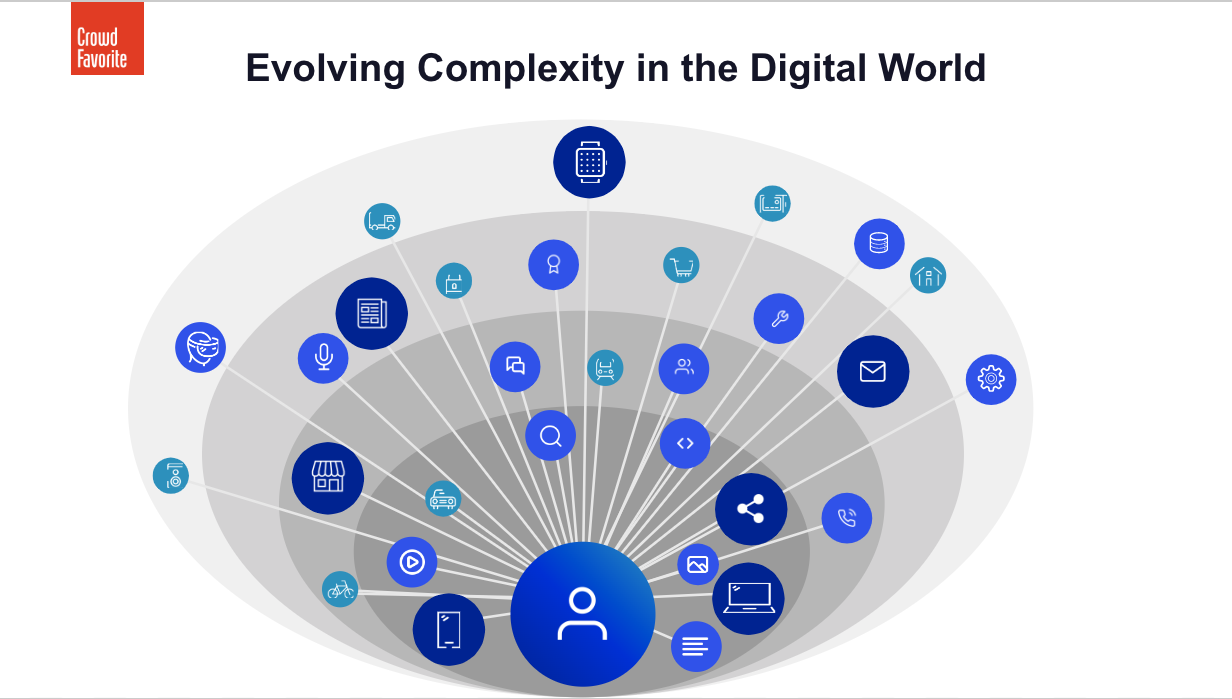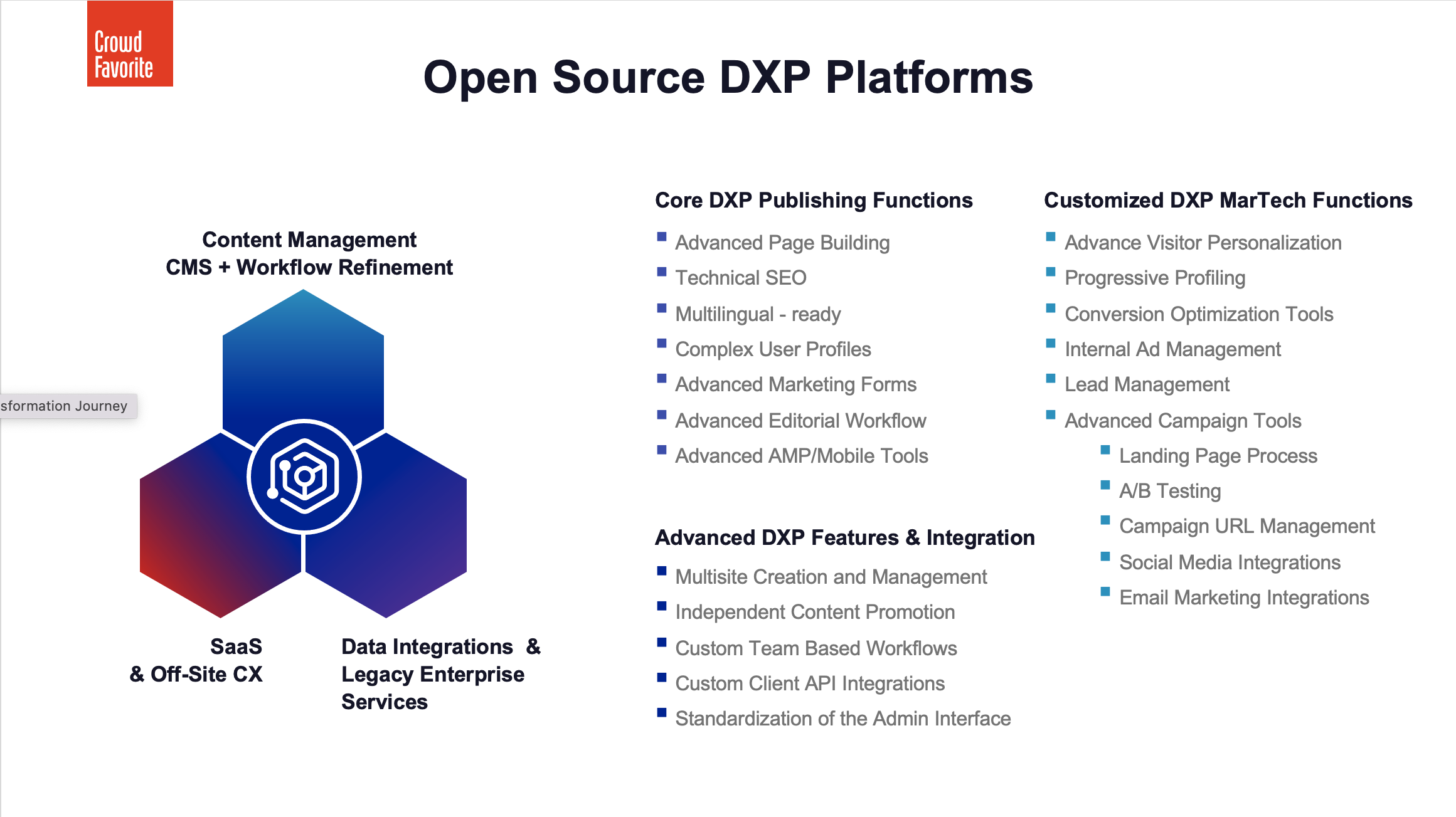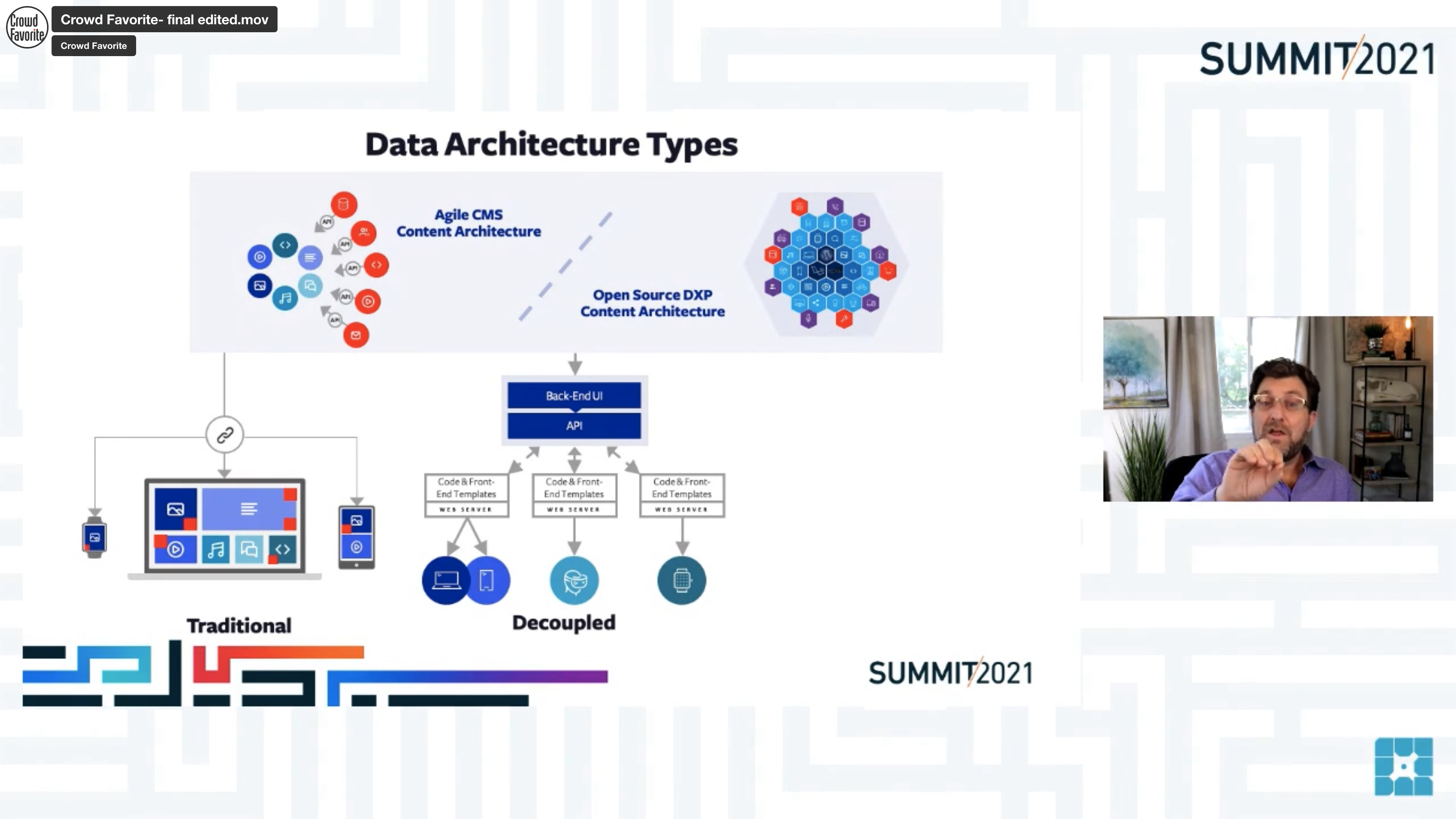| Karim | Hello. My name is Karim Marucchi. I am CEO at Crowd Favorite. First of all, I'd like to thank WP Engine for letting us come and present with you at Summit 2021. It's a pleasure to be here. I would love to invite you to join us today. We are going to be covering our executive guide for Agile CMS, DXP, and the headless systems, and what's right for your brand. This is going to be a non-technical talk. This is a talk for folks who do come to events like WP Engine Summit, but then need to go back and speak to decision makers who might not be as technical as we all are and try and understand what is the best decision for them. So, this was meant as a tool and a guide of what might they might find important. Today we're going to be basing our talk on the strategy sessions that Crowd Favorite does with new incoming clients when they do come in and ask for a hand on creating a strategy for an implementation of a digital transformation. So, let's take a look. There we go. First thing that always happens is we have clients who have tons of content, functionality, requirements, and we basically have to understand what's right for them. Are they going to go to a CMS? Are they going to go to a DXP? Do they need to go headless? Where are they going to go?
So, in today's world, there's a lot of choices out there. What we try to do is talk to them about, let's take a look at the complexity of your content and what you need to do. Let's take a look at that for a second. Way back when, those of us who have been in the internet a long time can remember when a simple CMS that just pushed media and text and images, maybe went to social media. When it came along, it was something that was simple and easy to manage.
Then eventually we started bringing in the store experience of e-commerce. We started to bring in CRM information and wanted to publish customer information to the CRM system. We had reviews, intelligent term search, and even personalization. On top of that now, not only do we have much more complex outbound campaigns being run through the digital systems, but also we're looking directly to voice systems like Alexa and Google Home. So we want all that data to be available in different aspects.
And finally, with the rise of IoT and the internet of things, what's ending up happening now is clients are asking us to push data, raw data, that's not formatted directly to devices, and bring some data in directly from third-party legacy systems. So, it gets ever more complex. And they're asking us, "How do we make that decision?"
So, this is a way we look at things. I'm going to take you through the process real quick. When they come to us, the first thing we look at, as we said, is the content architecture, and there we say, "Do you need an agile CMS, a DXP, or what are you looking for?" Once we've determined that, and we'll go through the steps a little bit, we talk about data architecture.
At that point, whether you've chosen an agile CMS or a DXP, it's time to talk about traditional platforms, such as WP Engine, right off the base, a decoupled system, or going fully headless with a new WP Engine systems, as well as coming in and using some of the other legacy systems that you might have on site, and just bringing all that together. Once you've made that decision, then it's time to look at what is the right mix of your content management system in the details and the technology. We're not going to be going that far today, but just to give you an idea of how the steps progress.
So, let's take a look at the first step, shall we? Agile CMS. Those of us who have been around for a while remember when CMSs were very simple and straightforward. We had a little bit of media, a little bit of content, and we were just able to publish things directly. Over the last 10 years, we've seen the rise of the application framework. And through APIs, we can see how we are literally being able to bring in third-party information, and sometimes even push third-party information. But this has made it much more powerful for us to bring content directly onto the website, and it starts having more dynamic interaction with a client.
In the last few years, we've started talking about a customer 360 degree experience, of being able to talk to the customer everywhere not only on the laptop, but on their devices, in stores, directly on whatever channels that you may have. In this case, an Agile CMS is really going to be good for you, because probably while you're watching this, on another track there's our friend Mike Sanchez from Bold who was giving a talk on commerce and how their SaaS commerce system can work so well.
That's an exact example of what could be happening here in one of these red dots you see where e-commerce being so intensive, you could have that offsite and still integrate it and have that come into the website very seamlessly with an Agile CMS. So, it really makes a lot of sense to look at a CMS no longer as just what's managed in the system, but also how the data comes in and out.
Now, the other side, the limitations. If you're going to scale past a certain size, it's going to be a little bit different for every organization. But if you're going to scale past a certain size of how many things are going on at the same time, you can see that very quickly it can get very hectic, because you're probably managing multiple, multiple systems with multiple admins, multiple ways of getting the data in and out. And your content team, whether it's one person or 50 people, it is going to start to have more and more customized processes that cost time, money, training, and ultimately depending on your organization, could even cause turnover.
So, really understanding what limits an Agile CMS has before you should be looking at what the next step is, is important. But that doesn't mean that literally the... We have Fortune 500 clients who use Agile CMS instead of bigger, longer term DXPs because they don't have the need. They have been able to manage the number of SaaS or third-party applications that are going in and out, and they've been able to really make it the most robust yet simple CMS possible.
So, let's take a look at the other side now, DXPs, a digital experience platform. It's something that's very interesting because there really are two sides to it. The rise of the DXP really came along with Adobe and Cycore when they decided to really try and make an all-in-one solution. They wanted you not only to have CMS pieces, but also customer pieces, landing pages, see outbound, AB testing, personalization, social, everything in one system. And they are leaders, according to Forrester and Gartner, of the pack when you talk about these all-in-one DXP solutions.
The problem with the all-in-one DXP solutions is that they are proprietary, that they are 100% SaaS. They have very limited ways that you can interact with third-party systems, and it's very hard to churn onto another product. So, if you're not happy, it's very hard to get out. If you already bought into the Adobe ecosystem or you understand your digital strategy for a product like Sitecore going forward for a very long time, it might make a lot of sense, but is there an alternative?
Well, the alternative is obviously open source. We're here at WP Engine's Summit, and WP engine is a great platform for an open source DXP. We've built quite a few, and our clients are very happy with them. And those advantages are no vendor lock-in, no licensing, literally the control of data. It's very important these days for a lot of our clients to understand not only how the data is traveling, but also where it's resting and who has access to it. And you have more control with an open-source system than you do with one of these SaaS-based systems.
You can innovate much faster because of the open source world. You literally have this massive install base. And last but not least, because it's the number one thing that our clients thank us for, is total cost of ownership. Total cost of ownership on an open source DXP system is much smaller than one of these systems even for the short term, even over the first 24 or 36 months.
So, what does that look like as opposed to the other one? Well, all in all, it looks a lot like what we were just looking at with the other system. You have almost all the features available almost right outside of that, depending on who you're working with. Clients of ours tell us right up front what their requirements are, and we can launch pretty much day one that we're launching with the same types of functionality that we have with the all-in-one systems.
How do we do that? Well, what we do is we start with a core, a pure open source core. So, we think of it as a hub and spoke model. The hub of the system becomes open source, and WP Engine is really the platform that we really have honed on to over the last few years.
Then we start adding the traditional pieces that you might think are part of a more complex content management system. On top of that, you start adding the personalization, you start adding the different types of data streams that go in and out that are managed within the system. Then as a final step, we're also adding the SaaS and third-party integrations all as one system. These aren't separate any longer. They're built to interact as one.
And as the final step, what we do is we create one interface and one process that's custom and unique to each individual client so that they're not having to learn a bespoke system that's out there just to be the same for everyone depending on what the application is, or have many different systems, but they're able to literally have one system and one editorial and content management process.
So, once you've made that decision, you know what? An Agile CMS is already going to be more than enough because we are not going to go more than, it's going to be different for every client, but more than a certain size over the next five or six years. Or you say, "All right. We're ready to go to a DXP because we're already in a state where we have the need to be able to bring those things together. We're going to save lots of time and money and resources by bringing things into one process," then it's time to talk about data architecture.
It's never been a question of do you do headless or do you do a CMS. It's a question of after. We get a lot of confusion with folks who aren't technical, who say, ``Well, at what point do I decide whether I'm going traditional, decoupled, or headless?" Well, it's after this point when you've decided how complex your system is going to be. Now we say, "All right. Let's talk. We've talked about the content. Let's talk about the data structure."
And again, we start with this concept up. Along the top here, you can see whether we're using an agile CMS or a DXP, it really doesn't matter. If you're using a traditional structure, you are going to be pushing it directly to those same devices and however your development team is pushing to that end goal. If you've decided to go decoupled, it's because you've decided that you need to have separate channels, separate front ends, separate ways of interacting with certain things.
Here we have the example of a device or virtual VR, and then the web and the mobile are sharing one interface. But it could be very different things. But you'll notice here that the system is going from the backend to an API, and everything's hooking up to the API through web servers. That's decoupled.
The last, most complicated piece is endless. This is where folks go, "Okay, well, what's the difference between decoupled and headless?" Again, the non-technical version because I know my friends are going to call out a lot of details technically that I'm leaving out here. But this was made to really understand the essence of it. Instead of the API going directly to a web server, you can go directly to the database. You can go directly to the APIs. You no longer have to have a front end because it is completely decentralized. That is the difference.
Now, there's lots of reasons why everybody who has a technical background says, "Well, I want to pick one of these three." Well, at Crowd Favorite, we've found over the last few years that there are four top reasons why organizations pick either decoupled or headless as opposed to traditional headless. Well, why is that, you might ask? Are they saying, "Well, that's the reason to do that rather than it being default of the headless"?,
Well, headless, up until now, has been extremely expensive in the way of just the ramp up, setting up the infrastructure. Now, finally, with Atlas from WP Engine and with other products that are out there to make the experience more integrated, it's becoming more cost effective, so the bar is coming down.
But up until now, these are the four primary reasons. Either we have an enterprise client who already is omni-channel publishing, and they have multiple systems that they're dying to get back into one workflow and one way of tying everything together, or they have performance needs that are very bespoke. But we have seen tests with WP Engine where you can get a 10X performance boost on going through headless.
The security model is completely different from traditional hosting, and much more robust. And finally, depending on what your existing infrastructure is, getting all your data 100% accessible to all the other platforms may have a giant upside that isn't just about publishing over the internet, but might have to do with your internal business.
So, hopefully that was an interesting quick deep dive for non-technical folks to understand the differences in how these things come together. We would be happy to talk to you at any time and help you understand how your journey is going to progress. Please join us here at the event at Summit 2021. Hoping to talk to you soon. Thank you very much, and I hope you have a great rest of the event. |



